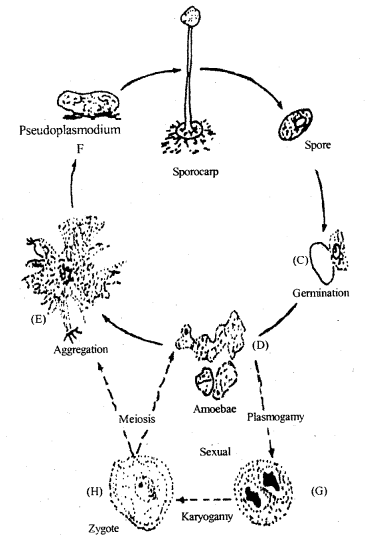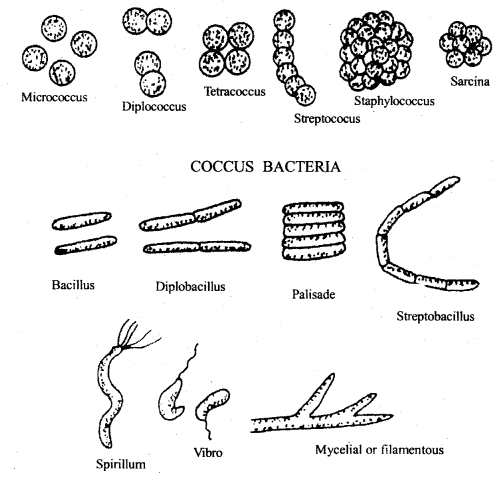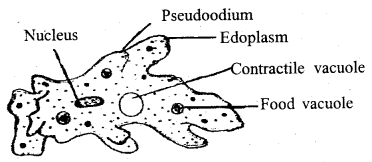Chapter 2 Biological Classification
Class 11th Biology Important Questions
Class 11 Biology Chapter 2 Important Extra Questions Biological Classification
Biological Classification Important Extra Questions Very Short Answer Type
Question 1.
What are imperfect fungi?
Answer:
Asexually reproducing
fungi belonging to Deuteromycites are imperfect fungi
Question 2.
How many basidiospores are formed after Karyogamy and
meiosis?
Answer:
4
Question 3.
What is plasmogamy?
Answer:
Fusion of protoplasms
between two motile or non-motile gametes.
Question 4.
What do you mean by mycorrhiza?
Answer:
Mycorrhiza is a
symbiotic association between fungi with roots of higher plants.
Question 5.
How does the spore of slime molds disperse?
Answer:
By
air currents
Question 6.
Name the protein-rich layer found in Euglenoids.
Answer:
Pellicle.
Question 7.
Give an example of red dinoflagellates?
Answer:
Gonyaulax.
Question 8.
Who is known as ‘Producers of the oceans’?
Answer:
Diatoms
Question 9.
Name the organism responsible for algal bloom?
Answer:
Blue-green algae.
Question 10.
Who has discovered viroids?
Answer:
T.O. Diener.
Biological Classification Biology Important Extra Questions Short Answer Type
Question 1.
What are the slime molds?
Answer:
1. The slime molds are
both plant and animal-like.
2. They are plant-like in the production of spores during reproduction and animal-like in the mode of nutrition and rheumatic organization.
3. Their rheumatic structure consists of an acellular, multinucleate mobile mass of protoplasm which lacks a good wall called plasmodium.
4. The reproductive stage consists of sporangia and spores formed after meiosis. The spores on germination produce either flagellated swarm cells or myxamoebae.
5. These divide mitotically, then behave as gametes and fuse in pairs to form a diploid zygote. The zygote nucleus divides mitotically but the nuclear division is not followed by cell wall formation so that all nuclei lie free in the cytoplasm.
6. The enlargement of the zygote into plasmodium takes place which moves freely on the substratum and feeds on bacteria, fungal and algal spores, and also absorbs nutrients directly from the substratum. The plas¬modium then settles on dry places and develops into sporangia. Therefore asexual stage is plant-like and the sexual stage is animal-like.
Question 2.
Write a short note on kingdom Plantae.
Kingdom Plantae
Answer:
1. Kingdom Plantae includes
all autotrophic plants which are photosynthetic forms called green plants
starting from simple algae, bryophytes, pteridophytes to gymnosperm and
angiosperms.
2. The plant cell has a cell wall mainly made of cellulose and, eukaryotic structure with prominent chloroplasts. Some plants are heterophilic like insectivorous plants which feed on insects and flies e.g. Bladderwort and Venus flytrap.
(3) The life cycle has two phases-sporophytic and gametophytic which are diploid (2n) and haploid (n) respectively. That means zygote (2n) undergoes meiosis to form haploid (n) spores these spores germinate into a gametophyte, then these gametes (male and female) fuse to form a zygote (2n) again which gives rise to the sporophyte. This phenomenon is called the alternation of generation.
Question 3.
Write a short note on Mycoplasma.
Answer:
- Discovered by E.Nocard and E.R. Roux (1998) mycoplasma is the smallest known aerobic prokaryotes without a cell wall.
- They were isolated from cattle suffering from bovine pleuropneumonia and hence they were designated as PPLO (pleuropneumonia-like organisms)
- They are found in different forms as a spheroid, thin, stellate called pleomorphic.
- They occur in soil, sewage, human, and plants.
Question 4.
Write a short note on Kingdom Animalia.
Answer:
- Kingdom Animalia includes all animals except the protozoan. The members are multicellular eukaryotes. The cell wall is absent cells, organized into tissue. They directly or indirectly depend on plants for food.
- They digest their food in an internal cavity and store food reserves as glycogen or fat. They are heterotrophic and the mode of nutrition is holozoic nutrition. They act as decomposers and help in the recycling of minerals.
- Kingdom Plantae includes the multicellular, photosynthetic eukaryotic forms.
- They have well-established mechanisms for absorption and Kingdom Animalia includes all animals except the protozoans. They are multicellular eukaryotes and are holozoic. The cells lack walls.
Question 5.
Write a short note on Lichens.
Answer:
Lichens are a
symbiotic association between algae and fungi. The algae component is known as
phycobiont and the fungal component as mycobiont which are autotrophic and
heterotrophic respectively. Algae prepare food for fungi and fungi provides
shelter and absorbs mineral nutrient and water for its partner.
On the basis of the structure of thallus, lichens can be classified into three types
- Crustose: forms a crust on the substrate which is not easily separated from the substrate e.g. Graphis
- Foliose: forms the leafy lobed structure attached to the substrate with the help of rhizines easily separated from substrate eg. Parmelia.
- Fruticose: forms shrubby, cylindrical, and branched thallus. They grow erect or hang from the substrate e.g. Usnea. Lichens are the pioneer colonizers of bare rocks. They also colonize tree trunks in temperate climatic regions.
Biological Classification Biology Important Extra Questions Long Answer Type
Question 1.
Describe the kingdom Monera.
Answer:
This kingdom
comprises single-celled prokaryotic organisms like bacteria, filamentous
actinomycetes, and photosynthetic blue-green algae of Cyanobacteria. The salient
features are already given in Table 2.1 we will further discuss the following
organisms briefly.
Bacteria: Bacteria are single-celled microscope true prokaryotic organisms
which are almost omnipresent. They colonize soil, water, and air. These can
survive
in extreme environmental conditions like high temperature,
high salt concentration, in absence of oxygen (anaerobic) or in presence of
oxygen (aerobic) in high acidic or alkaline pH, etc. (sometimes these are called
Archaebacteria).
Some bacteria can be chemotrophs that derive energy from inorganic compounds in absence of oxygen e.g. methanogenic bacteria produce methane gas (CH4) from CO2 and H2, some live by oxidizing hydrogen supplied eg. Thiothsix.
Some are parasites on plants and animals e.g. Xanthomonas citri and Vibrio Cholera; another form symbiotic association with plant roots e.g. Rhizobium.
The bacteria can be of various sizes and shape i.e. spherical or round, coccus (pi. cocci), rod-shaped and bacillus (pi. Bacilli), spiral-shaped spirillum (pi. Priscilla). Long and helical shaped called spirochetes. Many bacteria have one or more slender, long flagellum (pi. flagella) which helps them to move in the liquid substrate. Some bacteria form endospores under poor nutrient conditions.
Question 2.
Write the distinct characters of protozoa.
Answer:
1.
Protozoa are single-celled heterotrophs or ‘first animal’. They can be
free-living and parasitic members, mobile with flagellar movement, by
pseudopodia, or by ciliary movements e.g. Euglena and Amoeba.
2. Cell wall is absent in some like Amoeba so they can change their shape. The Euglena is autotrophic because of the presence of chlorophyll it performs photosynthesis but in the absence of light, it becomes heterotropic and ingests other protists or food particles.
3. They reproduce asexually by binary fission but some reproduce sexually by
fusion of gametes followed by meiosis. Another important member of protists is
the malarial parasite, Plasmodium, causing the notorious disease malaria in man,
carried by mosquitoes, it multiplies rapidly in the liver of humans and brings
about the cyclic fever releasing toxins into the bloodstream of its
host.
Photograph of Amoeba and Euglenas